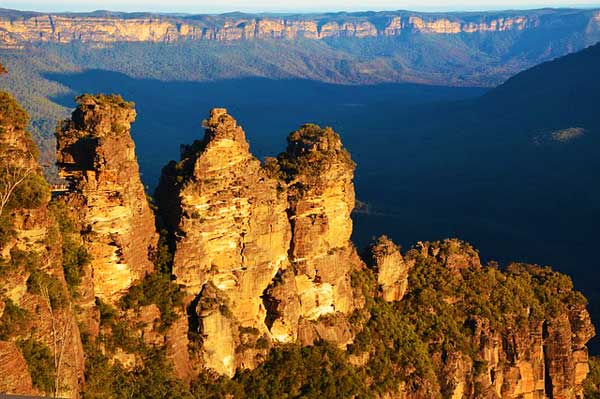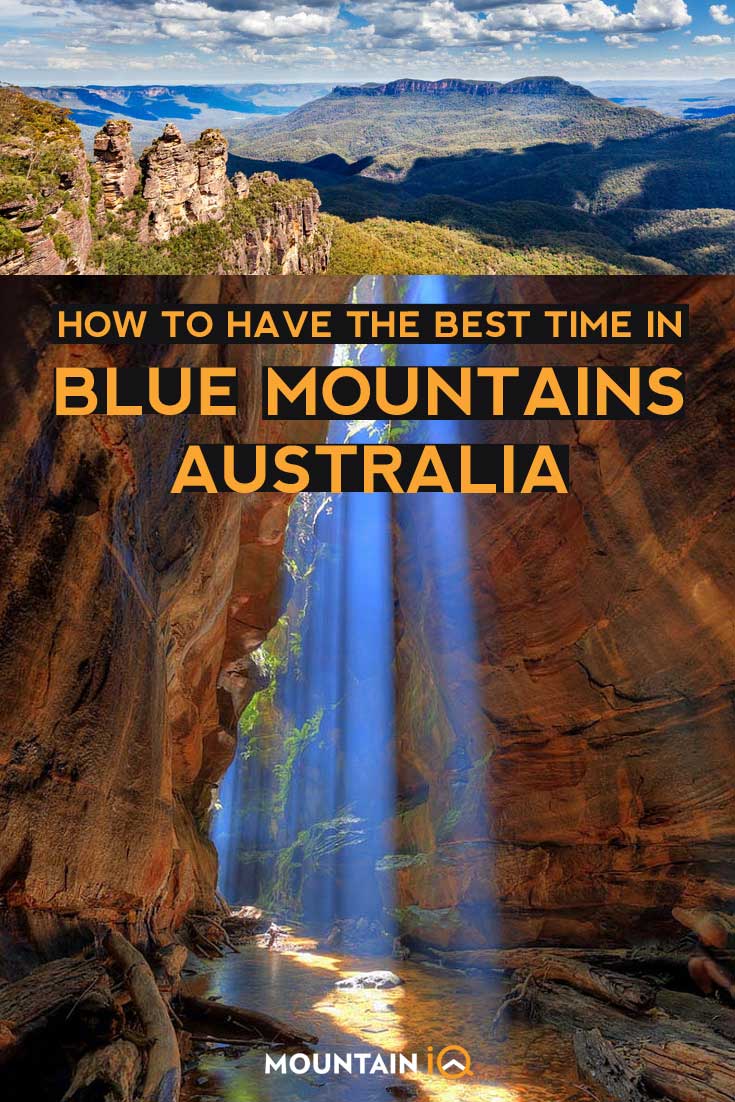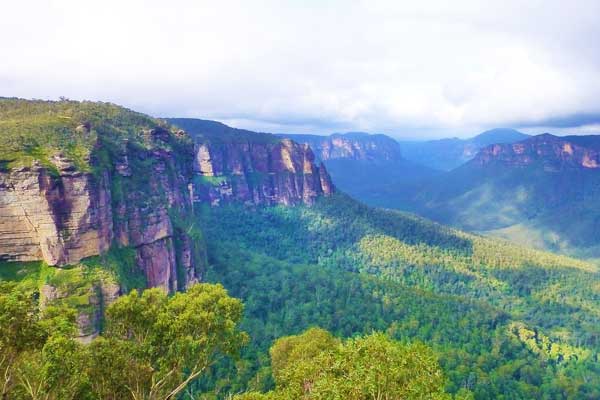The enchanting Blue Mountains are located in New South Wales, Australia, about 50km west of Sydney. The region was inhabited for millennia by the Gundungurra aboriginal people, before Europeans joined them in the 1700s.
The Blue Mountains own their name to the blue haze which is refracted when oily droplets from evaporated eucalyptus leaves mix with dust particles and water vapour in the surrounding air.
Read on for an overview of the physical geography, climate, wildlife, some of the notable mountains, as well as some exciting activities that you can fill your time with in the area.
The range is notorious for its bad weather, although its rugged, wild beauty more than makes up for it.
See more mountains in Australia.
The Blue Mountains - Overview
From 2000, thanks to their unique landscape, vegetation and wildlife, the mountains have been listed as an official World Heritage Area by UNESCO.
The mountains have historically been named the Carmarthen hills and the Lansdowne hills by Westerners until the more poetic current name eventually stuck.
The area offers tourists with a multitude of daytime, and multi-day adventures, including hiking, interacting with wildlife, rock-climbing and exploring caves.
See best hikes in Australia, featuring a hike from this region.

Notable Blue Mountains And Peaks
Below are five of the tallest, and most famous in the Blue Mountains region. Although, the highest peak remains unnamed.
Mount Piddington
Mount Piddington is located in the Explorer Range of the Blue Mountains, just south of the village Mount Victoria in New South Wales. It stands at 1,094 m or 3,589 ft tall and forms an imposing part of the surrounding landscape.
The mountain was named after William Richman Piddington, a historical colonial landowner in the area.
More recently, there have been monumental rock-climbing achievements on the mountain. For example, when it was first freed by Mike Law in 1973 and became the hardest climb in Australia.
A loop road from the nearby village provides access to the bush walks, trails to caves and rock-climbing areas.
Mount Boyce
Mount Boyce is situated in the Explorer Range of the Blue Mountains, 2km north of the town of Blackheath. It forms one of the highest points of the surrounding plateau at 1093m (3586ft) and is just east of a sharp cliff which drops to the Kanimbla Valley.
The feature was named in 1923 after Venerable Archdeacon Francis Bertie Boyce, a well-respected social reformer and clergyman who died in Blackheath.
The mountain provides climbers with a number of crags which allows for sport, mixed and traditional climbing options.
Mount York
Mount York is also a notable feature of the Explorer range, just outside the village of Mount Victoria. The hill consists of a relatively flat dissected plateau with a minor rise at its 1061m (3481ft) peak.
This mountain provided the view of the Australian “west” for early farmers and its summit is commemorated as such.
There is a trail which loops from Hartley Vale and takes about 5 hours, for those interested in appraising the land from a more revealing perspective.
Mount Banks
Mount Banks (1049m) forms part of the Explorer range and is 8km from Mount Tomah, the nearest residential area.
It is easily accessible Bells Line of Road, which leads to a picnic spot and onward to a quick 1km track to its summit and the option of continuing on, following a fire trail. Bushwalking and photography is popular in the area because of the impressive views of the Grose Valley from these trails.
One characteristic that visitors are sure to notice is the diversity of the vegetation as they approach the summit. The hike starts with Triassic sandstone, after which you will encounter a basalt cap and finally a more densely vegetated environment with an overhead canopy and thick grass.
Activities in the Blue Mountain Range
Blue Mountain Day Hikes
The Blue Mountains are well known for a network of hiking trails which are easily accessible by car or by train from Sydney. It is best to go on a weekday as this is a popular destination for tourists and locals alike.
Round Walking Track
One of the most highly recommended hikes to do in the region is the Round Walking Track which is relatively easy, really quick and leads you to impressive vistas of the iconic Three Sisters rocky outcrop as well as the Katoomba Falls. The walk is only 1.2km and the reward for such minimal effort seems totally undeserved.
Grand Canyon Walk (aka Heritage Walk)
If you are looking for a bit more of a challenge, consider the Grand Canyon walk of 6.3km. This loop starts and end at Evans Lookout and passes through shaded vegetation of ferns and golden wattles. The path follows Greaves Creek for most of the route so you’ll encounter creeks and water falls along the way.
Cliff Top Walking Track
If you’d like to extend the trip to a full day’s walk you can add on the Cliff Top Walking Track for some bird-watching, to appreciate the wild flowers and to enjoy some afternoon sunshine.
Federal Pass
Another, longer day-hike that we would recommend is the Federal Pass, which is a 26km roundtrip and leads from Leura to the Ruined Castle past some of the most iconic Blue Mountains scenery, including the aforementioned Three Sisters. It is possible to shorten this hike if you are not up to the full 6-hour journey by walking back to the Golden Stairs at the start of the Ruined Castle walk.
Explore Jenolan Caves
The Jenolan Caves are the most ancient discovered open caves in the world, with a 40km network of subterranean passages and more than 300 entrances.
The limestone walls include marine fossils and beautiful, pure white calcite formations, a privilege to see for any visitor.
As a popular tourist destination and the underground tunnels are lit for an impressive viewing experience.
There are options to tour different combinations of the 11 caves, some more physically demanding than others.
However, this is certainly an experience that is open to people of all fitness levels. The tours are open every day (except the 25th of December) and run from 10am to 5pm.
Bus tours to the Blue Mountains
There are many options for touring companies which give visitors easier access to the vistas of the Blue Mountains than walking does. The tours are also perfect if you do not have the time to research and spend time in the mountain, and only have a day to explore.
Some of the tours include short walking sections in carefully selected regions of the mountains.
There are tour options which provide detailed information on the indigenous flora and fauna for those interested in the ecology of the area.
The tours also function in a variety of ways. For some you can spend as much time as you’d like at the different hop-off spots and for others you are driven briefly to some of the key attractions.
You have the option of joining a full-sized bus tour or a mini-bus tour. We recommend the latter, if you can spare the extra cash, as they can transport you around the area efficiently and less time is spent waiting for fellow tour-group members to embark and disembark at each stop. On average, the tours run for about 9 – 10 hours.
Although each of the tours are different, generally, a combination of the following stops is included.
- Echo Point: From where you will have an exquisite view of the Three Sisters
- Blue Mountains Villages: Most tours include visits to either Katoomba or Leura
- Featherdale Wildlife Park: Many of the tours spend up to an hour here. This is a great option for people who want time to interact with Aussie wildlife, like koalas and kangaroos.
- Scenic World: This park offers a range of experiences which optimise the viewing of the surrounding landscape. These include gliding over the forest in cable cars, rambling along gorgeous elevated walkways, or chugging along the steepest railway in the world. While these options all provide a quick and impressive vies of the mountains, they do have long lines especially during the weekends.
The best advice we can give to book your tour, is to make sure that you know what your priorities are before doing so – and then book accordingly.
Blue Mountains FAQ
Why are the Blue Mountains blue?
The Blue Mountains got their name because from a distance they do indeed look blue. They are covered in dense forests of eucalypts, or gum trees, which produce a fine mist in the hot sun. This mist reflects light and creates a bluish hue around the mountains.
When is the best time to visit the Blue Mountains?
Summer (December to February) and Autumn (March to May) are the best time to visit the Blue Mountains in Australia. Although it may still be a bit rainy in the summer time.
Does it snow on the Blue Mountains?
The Blue Mountains do experience some snowfall in winter. However, there are generally only about 5 snow days on the mountain peaks per year - despite the cold temperatures.
More mountain ranges in Australia:

References: Australian Tourism, Wikipedia

